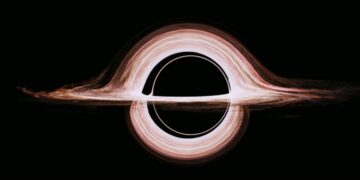The concept of warp drives has fascinated science fiction fans and physicists alike for decades. While still purely theoretical, the idea of a warp drive—a technology that allows faster-than-light travel by bending spacetime —continues to be a popular topic of discussion. Recent research by Remo Garattini and Kirill Zatrimaylov, published in Physics Letters B, takes this concept a step further by exploring what might happen if a warp-drive spaceship entered a black hole. This thought experiment opens up intriguing possibilities for both the future of space travel and our understanding of black holes.
The Warp Drive: A Sci-Fi Staple with Real Science Behind It
Warp drives are not just a staple of science fiction, made famous by shows like Star Trek; they are also grounded in theoretical physics. The idea was first formally proposed by Mexican physicist Miguel Alcubierre in 1994, who suggested a method of warping spacetime to allow a spaceship to travel faster than light without violating the laws of physics. This would require a warp bubble, a theoretical region of space where spacetime is compressed in front of the ship and expanded behind it, allowing for faster-than-light travel.
However, creating a warp drive is not without its challenges. The energy required to generate and sustain a warp bubble is enormous, potentially more than what is currently possible with our understanding of physics. It also requires exotic matter with negative energy density, a substance that remains hypothetical and has not yet been observed in nature.
Entering a Black Hole with a Warp Drive: The Theoretical Model
Garattini and Zatrimaylov’s research adds a new layer to the discussion by considering what might happen if a warp-drive spaceship tried to enter a black hole, specifically a Schwarzschild black hole. Schwarzschild black holes are non-rotating, uncharged black holes that provide a simplified model for studying the complex mathematics of black holes. The researchers theorized that, under certain conditions, a warp drive could survive the extreme gravitational forces at the event horizon of a black hole if it crossed at sub-light speeds.
The key finding is that the black hole’s gravitational field could reduce the amount of negative energy needed to sustain the warp bubble. This means that, in theory, a spaceship could pass through a black hole without being destroyed by the immense gravitational forces. The warp bubble could even erase the black hole’s event horizon, allowing for a unique passage through spacetime.
Implications for Creating Mini-Warp Drives in the Lab
One of the most exciting implications of this research is the possibility of creating mini-warp drives in laboratory settings. The mathematical model suggests that the interaction between the warp bubble and the black hole could convert virtual particles into real ones within an electric field. If this could be replicated in a lab, it might lead to the creation of small-scale warp drives that could be used to test the principles of faster-than-light travel in a controlled environment.
While this concept is still highly theoretical, it provides a new direction for research in both warp drive technology and black hole physics. The idea that mini-warp drives could be built in labs opens the door to practical experiments that could one day lead to the development of real-world warp drives.
The Thermodynamic Challenges of Warp Drives and Black Holes
The researchers also delved into the thermodynamic implications of a warp drive interacting with a black hole. One interesting outcome is that a warp bubble moving slowly through a black hole could increase the black hole’s entropy. However, if a larger warp bubble were to completely pass through a black hole, it could produce a “screening” effect, effectively eliminating the event horizon and complicating our understanding of black hole entropy according to Hawking’s theories.
This points to an ongoing challenge in reconciling warp drive theories with our understanding of thermodynamics and black hole physics. If warp drives are possible, they could fundamentally change our perception of space, time, and the universe’s basic laws.
Why This Matters: Potential for Future Space Exploration
While warp drives and black holes might sound like pure science fiction, these concepts have real implications for the future of space exploration. If we can figure out how to create and control warp drives, even on a small scale, it could revolutionize our ability to explore deep space. The idea that a warp drive could navigate through a black hole and emerge unscathed offers tantalizing possibilities for future interstellar travel.
Imagine sending a probe with a mini-warp drive into a black hole, collecting data from inside the event horizon, and transmitting it back to Earth. This would provide unprecedented insights into one of the universe’s most mysterious phenomena and potentially redefine our understanding of physics.
Conclusion: The Future of Warp Drives and Black Hole Exploration
Garattini and Zatrimaylov’s research may still be in the realm of theoretical physics, but it pushes the boundaries of what we consider possible in space exploration. By combining the mathematics of warp drives with the unique physics of black holes, they have opened up new avenues for scientific inquiry and technological development. Whether or not we will ever see a real warp drive spaceship flying through a black hole, the exploration of these ideas continues to inspire scientists and fuel the imagination of future generations.
As we continue to explore these frontiers, the intersection of warp drive technology and black hole physics remains a compelling topic, suggesting that the universe may still have many surprises in store for us.
Research:
Garattini, R., & Zatrimaylov, K. (2024). Black holes, warp drives, and energy conditions. Physics Letters B.

















